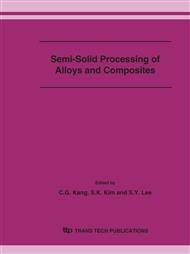p.64
p.68
p.72
p.76
p.80
p.84
p.88
p.92
p.96
Anodic Oxide Layer Formation on A357 Aluminium Alloy Produced by Thixocasting
Abstract:
Anodizing is widely used in the surface treatment of aluminium alloys in order to preserve the integrity of the alloy surface, to minimize the need for maintenance and repair, and to maximize the component life. The aim of this work is to study the influence heat treatments (T5 and T6) have on the anodization of A357 aluminium alloy produced by a Thixocasting process. In particular the effect of shape, size and distribution of silicon and intermetallic phases on the anodic oxide film formation. SEM and EDS analyses were used to examine the microstructural features found on, within and under the anodic oxide layer. Experiments using a tribometer (pin-on-disc tests) were performed in order to evaluate the friction and wear properties of the different layers.
Info:
Periodical:
Pages:
80-83
Citation:
Online since:
October 2006
Authors:
Price:
Сopyright:
© 2006 Trans Tech Publications Ltd. All Rights Reserved
Share:
Citation:


